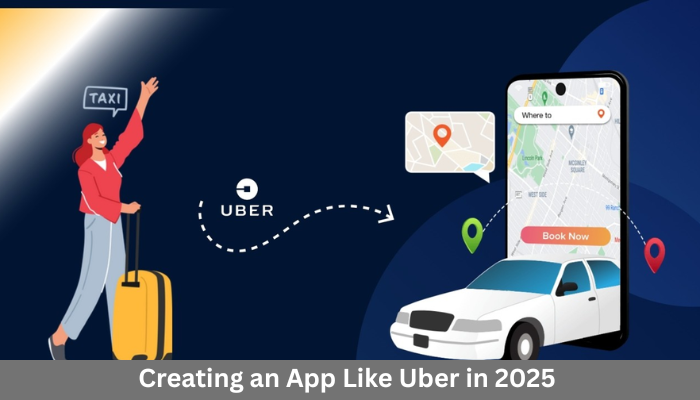The year 2025 is witnessing the blossoming of ride-hailing apps that provide much-needed convenience for real-time transportation. Uber stands out as the market leader; however, the scope remains wide open for innovative entrants. While considering Uber-like app development, it is essential to understand its technical, operational, and business aspects. This guide shall walk you through every bit of the step-by-step procedure and take cognizance of the things to consider when developing a worthwhile and scalable Uber-like app.
Step-by-Step Process to Build an App Like Uber
1. Conduct Market Research
Before development begins, identify your target audience and competitors. Analyze:
- Regional transport demands
- User preferences
- Regulatory challenges
- Unique value propositions (UVPs)
This helps in shaping the app’s features and positioning it in the market.
2. Define App Features (MVP)
Focus on building a Minimum Viable Product (MVP) with essential features. An Uber-like app generally includes three modules:
a. Passenger App
- Sign up/login
- GPS-based location search
- Ride booking
- Fare calculation
- In-app chat/call
- Live tracking
- Payment gateway
- Ratings and reviews
b. Driver App
- Registration and verification
- Trip request notification
- Navigation and GPS routing
- Earnings dashboard
- Accept/decline ride
- Ratings and feedback
c. Admin Panel
- User management
- Driver verification
- Trip and fare management
- Analytics and reports
- Payment settlements
3. Choose the Right Technology Stack
Your app should be scalable, fast, and secure. Here’s a sample tech stack for an Uber-like app:
| Component | Technologies |
|---|---|
| Frontend | React Native / Flutter |
| Backend | Node.js / Django / Ruby on Rails |
| Database | PostgreSQL / MongoDB |
| Real-time Tracking | Google Maps API / Mapbox, Socket.IO |
| Payments | Stripe, Razorpay, PayPal |
| Cloud | AWS / Google Cloud / Azure |
| Push Notifications | Firebase Cloud Messaging |
4. UI/UX Design
User experience is a top priority in mobility apps. Create intuitive, minimal, and responsive designs that:
- Allow quick booking in fewer taps
- Provide real-time location updates
- Ensure easy navigation for drivers
4. UI/UX Design
User experience is a top priority in mobility apps. Create intuitive, minimal, and responsive designs that:
- Allow quick booking in fewer taps
- Provide real-time location updates
- Ensure easy navigation for drivers
Tools like Figma, Adobe XD, and Sketch are ideal for creating user-friendly prototypes.
5. App Development
Divide the project into sprints for faster development using Agile methodology. Focus first on MVP features and expand later based on user feedback.
Development tips:
- Use microservices architecture for easier scaling
- Ensure real-time communication with WebSocket protocols
- Use RESTful APIs for secure backend interaction
6. Testing and QA
Test thoroughly on different devices, OS versions, and real-world scenarios. Types of testing:
- Functional Testing
- Usability Testing
- Security Testing
- Load & Performance Testing
7. Launch and Deployment
Publish the app on the Apple App Store and Google Play Store. Ensure that:
- All app permissions are clearly mentioned
- Data privacy policies are in place
- Server infrastructure can handle traffic spikes
8. Ongoing Support and Scaling
Post-launch, focus on:
- Regular updates
- Bug fixes
- Feature upgrades (pooling, loyalty programs, etc.)
- Marketing and user acquisition
Invest in analytics tools to monitor performance, retention, and behavior.
Key Factors to Consider in 2025
1. Rightful Legality
The app must abide by local transport and safety laws, including driver background checks, levels of insurance coverage, and surge price limitations.
2. Green Change
With climate change perspective arising, such offerings as EV option, ride pooling system, and carbon offset features will attract green users.
3. AI and Machine Learning Integration
Use AI for:
- Predicting ride demand
- Route optimization
- Dynamic pricing
- Fraud detection
Machine learning boosts operational efficiency and further exploits the user experience.
- Data Privacy and Security
Implement a method of encryption with the best quality possible, and comply with regulations such as GDPR. Make sure payments are secure and data policies transparent.
5. Multimodal Transport Support
Many apps now offer multiple transportation modes like:
- Bikes
- Scooters
- Public transit
- Car rentals
Consider integrating multiple travel options for broader appeal.
6. User Retention and Engagement
Offer:
- Loyalty rewards
- Referral discounts
- Personalized promotions
- 24/7 customer support
Keeping users engaged is crucial to building a sustainable ride-hailing business.
Conclusion
A 2025-era app that’s the sorter of yet Uber-ride needs to be far from just a clone of Uber, in that it must do some innovation, localization, and value creation for riders and drivers. Real-time GPS and map integration, AI-powered business-based insights, and green transport alternatives-the sky is the limit! Of course, with the right approach, technical stack, and execution, the Uber-like app can set itself and come into its own in this usually fiercely competitive mobility market.
Also Read : AI Chatbots Not A Threat To Search Engines—For Now
Frequently Asked Questions
Q 1. How long will it take to make a ride-hailing app?
A basic MVP takes about 3 to 5 months to build. An app, with advanced features such as AI recommendations, real-time tracking, and fleet management may take up to 6 to 12 months.
Q 2. What are the challenges in building an Uber-like app?
* Real-time GPS tracking and mapping
* Algorithms to match drivers with riders
* Ensuring payment security and integration
* Regulation and licensing
* User monetization and competing
Q 3. Can I launch an Uber-like app in a small city or town?
Yes. In fact, launching in under-served or niche local markets can be a strategic advantage. Make sure that you focus on affordability, safety, and reliability to gain trust.
Q 4. Do I need to set up two separate apps for the drivers and passengers?
Ideally, yes, since a passenger app and a driver app serve very different purposes and have very different user journeys; some startups initially pack the two into one with access for both.
Q 5. Do I need to set up two separate apps for the drivers and passengers?
Ideally, yes, since a passenger app and a driver app serve very different purposes and have very different user journeys; some startups initially pack the two into one with access for both.











